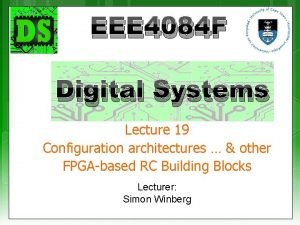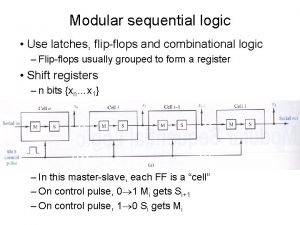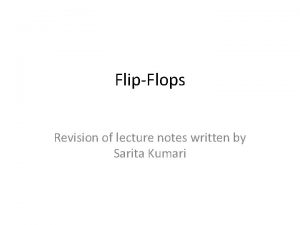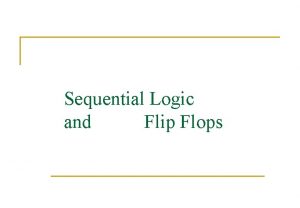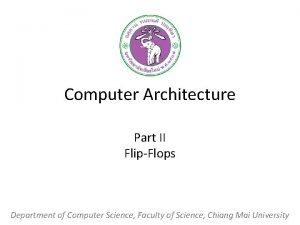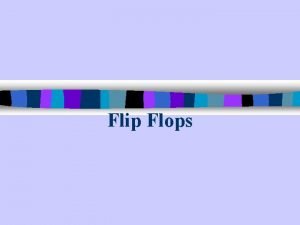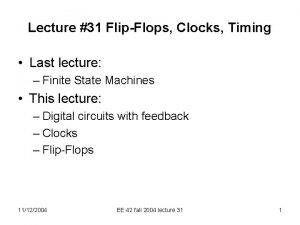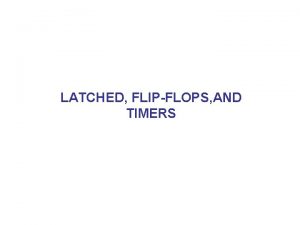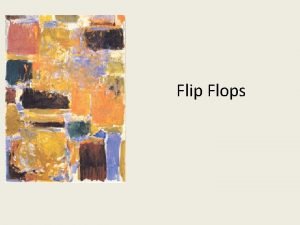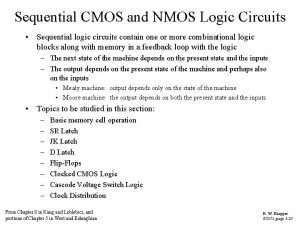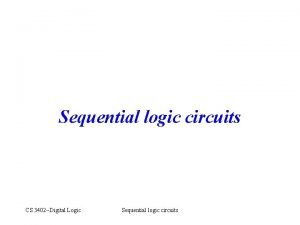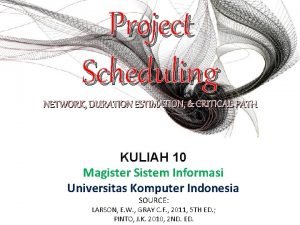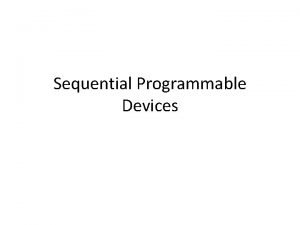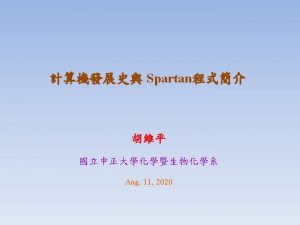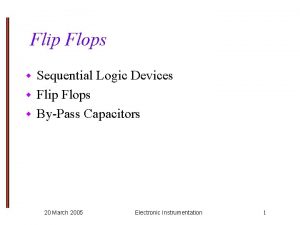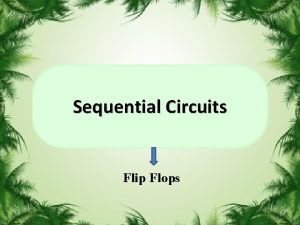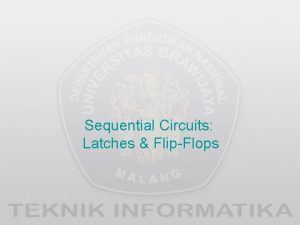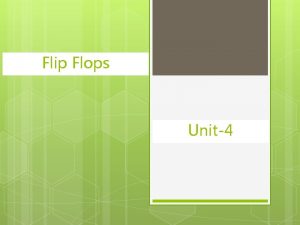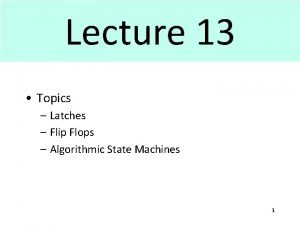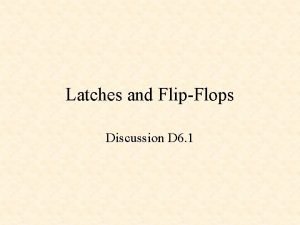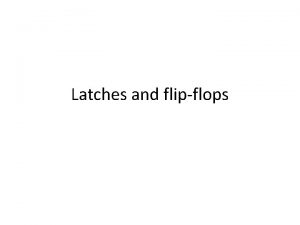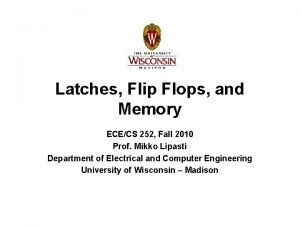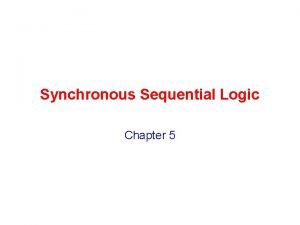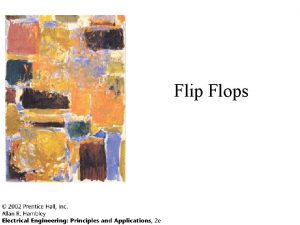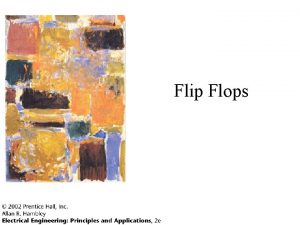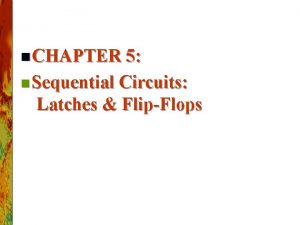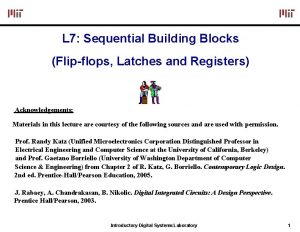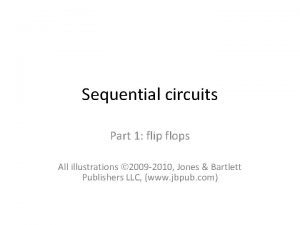Flip Flops Lecture 11 Sequential Logic Latches Flipflops























- Slides: 23

Flip Flops

Lecture 11: Sequential Logic Latches & Flip-flops § Introduction § Memory Elements § Pulse-Triggered Latch v S-R Latch v Gated D Latch § Edge-Triggered Flip-flops v v S-R Flip-flop D Flip-flop J-K Flip-flop T Flip-flop § Asynchronous Inputs CS 1104 -11 Lecture 11: Sequential Logic: Latches & Flip-flops 2

Introduction § A sequential circuit consists of a feedback path, and employs some memory elements. Combinational outputs Memory outputs Combinational logic Memory elements External inputs Sequential circuit = Combinational logic + Memory Elements CS 1104 -11 Introduction 3

Introduction § There are two types of sequential circuits: v synchronous: outputs change only at specific time v asynchronous: outputs change at any time § Multivibrator: a class of sequential circuits. They can be: v bistable (2 stable states) v monostable or one-shot (1 stable state) v astable (no stable state) § Bistable logic devices: latches and flip-flops. § Latches and flip-flops differ in the method used for changing their state. CS 1104 -11 Introduction 4

Memory Elements § Memory element: a device which can remember value indefinitely, or change value on command from its inputs. Memory element command Q stored value § Characteristic table: Q(t): current state Q(t+1) or Q+: next state CS 1104 -11 Memory Elements 5

Memory Elements § Memory element with clock. Flip-flops are memory elements that change state on clock signals. Memory element command Q stored value clock § Clock is usually a square wave. Positive pulses Positive edges CS 1104 -11 Negative edges Memory Elements 6

Memory Elements § Two types of triggering/activation: v pulse-triggered v edge-triggered § Pulse-triggered v latches v ON = 1, OFF = 0 § Edge-triggered v flip-flops v positive edge-triggered (ON = from 0 to 1; OFF = other time) v negative edge-triggered (ON = from 1 to 0; OFF = other time) CS 1104 -11 Memory Elements 7

S-R Latch § § Complementary outputs: Q and Q'. When Q is HIGH, the latch is in SET state. When Q is LOW, the latch is in RESET state. For active-HIGH input S-R latch (also known as NOR gate latch), R=HIGH (and S=LOW) a RESET state S=HIGH (and R=LOW) a SET state both inputs LOW a no change both inputs HIGH a Q and Q' both LOW (invalid)! CS 1104 -11 S-R Latch 8

S-R Latch § Characteristics table for active-high input S-R latch: CS 1104 -11 S-R Latch S Q R Q' 9

S-R Latch § Active-HIGH input S-R latch 10 100 R Q 11000 10 001 S Q' 0 0 1 1 0 CS 1104 -11 S-R Latch 10

Gated D Latch § Make R input equal to S' gated D latch. § D latch eliminates the undesirable condition of invalid state in the S-R latch. D Q EN Q' CS 1104 -11 D Gated D Latch Q' 11

Gated D Latch § When EN is HIGH, v D=HIGH latch is SET v D=LOW latch is RESET § Hence when EN is HIGH, Q ‘follows’ the D (data) input. § Characteristic table: When EN=1, Q(t+1) = D CS 1104 -11 Gated D Latch 12

Latch Circuits: Not Suitable § Latch circuits are not suitable in synchronous logic circuits. § When the enable signal is active, the excitation inputs are gated directly to the output Q. Thus, any change in the excitation input immediately causes a change in the latch output. § The problem is solved by using a special timing control signal called a clock to restrict the times at which the states of the memory elements may change. § This leads us to the edge-triggered memory elements called flip-flops. CS 1104 -11 Gated D Latch 13

Edge-Triggered Flip-flops § Flip-flops: synchronous bistable devices § Output changes state at a specified point on a triggering input called the clock. § Change state either at the positive edge (rising edge) or at the negative edge (falling edge) of the clock signal. Clock signal Positive edges CS 1104 -11 Negative edges Edge-Triggered Flip-flops 14

Edge-Triggered Flip-flops § S-R, D and J-K edge-triggered flip-flops. Note the “>” symbol at the clock input. S Q C R D Q C Q' J Q C Q' K Q' J Q Positive edge-triggered flip-flops S Q C R D Q C Q' K Q' Negative edge-triggered flip-flops CS 1104 -11 Edge-Triggered Flip-flops 15

S-R Flip-flop § S-R flip-flop: on the triggering edge of the clock pulse, v v S=HIGH (and R=LOW) a SET state R=HIGH (and S=LOW) a RESET state both inputs LOW a no change both inputs HIGH a invalid § Characteristic table of positive edge-triggered S-R flipflop: X = irrelevant (“don’t care”) = clock transition LOW to HIGH CS 1104 -11 SR Flip-flop 16

S-R Flip-flop § It comprises 3 parts: v a basic NAND latch v a pulse-steering circuit v a pulse transition detector (or edge detector) circuit § The pulse transition detector detects a rising (or falling) edge and produces a very short-duration spike. CS 1104 -11 SR Flip-flop 17

S-R Flip-flop The pulse transition detector. S Q Pulse transition detector CLK Q' R CLK' CLK* CLK CLK CLK' CLK* Positive-going transition Negative-going transition (rising edge) (falling edge) SR Flip-flop CS 1104 -11 18

D Flip-flop § D flip-flop: single input D (data) v D=HIGH a SET state v D=LOW a RESET state § Q follows D at the clock edge. § Convert S-R flip-flop into a D flip-flop: add an inverter. D CLK S Q C R Q' = clock transition LOW to HIGH A positive edge-triggered D flipflop formed with an S-R flip-flop. CS 1104 -11 D Flip-flop 19

J-K Flip-flop § J-K flip-flop: Q and Q' are fed back to the pulsesteering NAND gates. § No invalid state. § Include a toggle state. v J=HIGH (and K=LOW) a SET state v K=HIGH (and J=LOW) a RESET state v both inputs LOW a no change v both inputs HIGH a toggle CS 1104 -11 J-K Flip-Ffop 20

J-K Flip-flop § J-K flip-flop. J CLK Q Pulse transition detector Q' K § Characteristic table. Q(t+1) = J. Q' + K'. Q CS 1104 -11 J-K Flip-flop 21

T Flip-flop § T flip-flop: single-input version of the J-K flip flop, formed by tying both inputs together. T CLK Q Pulse transition detector T CLK Q' J Q C K Q' § Characteristic table. Q(t+1) = T. Q' + T'. Q CS 1104 -11 T Flip-flop 22

End of segment
 What is the difference between latches and flip flops
What is the difference between latches and flip flops Tabella verità flip flop jk
Tabella verità flip flop jk Latches
Latches Flip flops ece
Flip flops ece Flip flops on motorcycle
Flip flops on motorcycle Sr flip flop truth table
Sr flip flop truth table Flip flops notes
Flip flops notes D flip flop truth table
D flip flop truth table Flip flops in computer organization
Flip flops in computer organization Flip-flops are not bistable devices.
Flip-flops are not bistable devices. Combinational logic sequential logic 차이
Combinational logic sequential logic 차이 Combinational vs sequential logic
Combinational vs sequential logic If x = 0 and y = 1, which output line is enabled?
If x = 0 and y = 1, which output line is enabled? 캠블리 단점
캠블리 단점 Majority circuit
Majority circuit Flipflops
Flipflops D latch
D latch Sr latches
Sr latches Cmos circuit
Cmos circuit Cs
Cs What is a nonserual sequential logic in project
What is a nonserual sequential logic in project What is a nonserual sequential logic in project
What is a nonserual sequential logic in project Spld cpld fpga
Spld cpld fpga Eniac flops
Eniac flops
